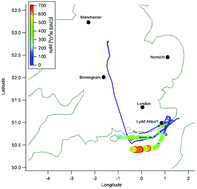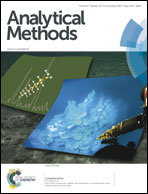The first airborne comparison of N2O5 measurements over the UK using a CIMS and BBCEAS during the RONOCO campaign
Abstract
Dinitrogen pentoxide (N2O5) plays a central role in nighttime tropospheric chemistry as its formation and subsequent loss in sink processes limits the potential for tropospheric photochemistry to generate ozone the next day. Since accurate observational data for N2O5 are critical to examine our understanding of this chemistry, it is vital also to evaluate the capabilities of N2O5 measurement techniques through the co-deployment of the available instrumentation. This work compares measurements of N2O5 from two aircraft instruments on board the Facility for Airborne Atmospheric Measurements (FAAM) BAe-146 aircraft during the Role of Nighttime Chemistry in Controlling the Oxidising Capacity of the Atmosphere (RONOCO) measurement campaigns over the United Kingdom in 2010 and 2011. A chemical ionisation mass spectrometer (CIMS), deployed for the first time for ambient N2O5 detection during RONOCO, measured N2O5 directly using I− ionisation chemistry and an aircraft-based broadband cavity enhanced absorption spectrometer (BBCEAS), developed specifically for RONOCO, measured N2O5 by thermally dissociating N2O5 and quantifying the resultant NO3 spectroscopically within a high finesse optical cavity. N2O5 mixing ratios were simultaneously measured at 1 second time resolution (1 Hz) by the two instruments for 8 flights during RONOCO. The sensitivity for the CIMS instrument was 52 ion counts per pptv with a limit of detection of 7.4 pptv for 1 Hz measurements. BBCEAS, a proven technique for N2O5 measurement, had a limit of detection of 2 pptv. Comparison of the observed N2O5 mixing ratios show excellent agreement between the CIMS and BBCEAS methods for the whole dataset, as indicated by the square of the linear correlation coefficient, R2 = 0.89. Even stronger correlations (R2 values up to 0.98) were found for individual flights. Altitudinal profiles of N2O5 obtained by CIMS and BBCEAS also showed close agreement (R2 = 0.93). Similarly, N2O5 mixing ratios from both instruments were greatest within pollution plumes and were strongly positively correlated with the NO2 concentrations. The transition from day to nighttime chemistry was observed during a dusk-to-dawn flight during the summer 2011 RONOCO campaign: the CIMS and BBCEAS instruments simultaneously detected the increasing N2O5 concentrations after sunset. The performance of the CIMS and BBCEAS techniques demonstrated in the RONOCO dataset illustrate the benefits that accurate, high-frequency, aircraft-based measurements have for improving understanding the nighttime chemistry of N2O5.

- This article is part of the themed collection: Celebrating the 2016 RSC Prize and Award Winners


 Please wait while we load your content...
Please wait while we load your content...